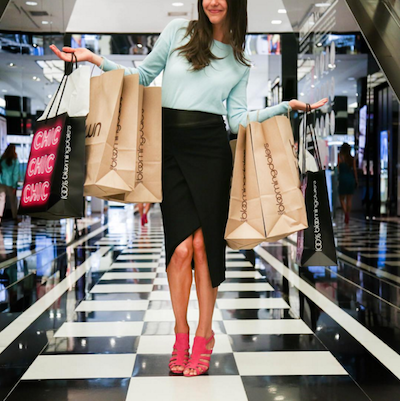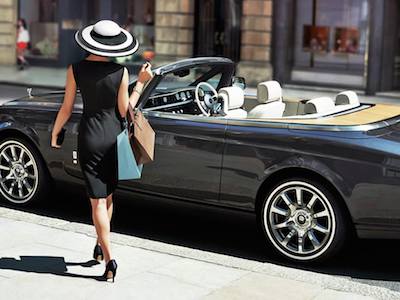For the first time since the economic crash in 2008, many top luxury CEOs are worried about the state of the industry, according to the Luxury Institute.
Issues ranging from the economy to the weather and internal service problems have contributed to a world in which nine of 10 would-be clients leave a store without a purchase and only 20 percent of the buyers return. Although the global economy and the weather are hard to control or predict, every brand has a chance to empower its sales associates to convert and retain sales.
“In the second half [of 2015] things turned ugly,” said Milton Pedraza, founder and CEO of Luxury Institute. “I had a CEO tell me she hasn’t seen so many negative factors working against the luxury industry since we recovered.
“Remember, after 2008, China decided it was going to go on a growth spurt–and I say ‘decided’ because they are a communist country–and that made up for all the other things in the rest of the world,” he said. “So it helped countries like the United States and it helped Europe to start recovering, but now all those things turned negative.
“There’s a dramatic slowdown in China; the dollar has strengthened so you are getting fewer tourists and exporting less out of the U.S.; Europe never recovered fully; you have luxury shifting toward experiences rather than goods; traffic is down in stores even in the U.S., and while stores are moving into online buying there is no way online buying is making it up, so a lot of companies are now discounting.”
Changing the game
In addition to complex economic issues rooted in global relations, a transition toward a digital economy and the buying patterns and behavior of both aging boomers and emerging millennials, uncontrollable factors such as weather are also capable of hurting stores. An unseasonably warm winter has made it so coats and other seasonal apparel is not selling as well this year.

Luxury shoppers
However, brands still have a chance to generate their own sales and ensure that those who do walk through the door make a purchase and return. Despite the hard emphasis on “selling,” sales and retention are a factor of relationship building first and foremost.
“There is a lack of empathy when you enter the store, a lack of trust when you enter the store and a lack of generosity you feel coming to you – when I say generosity I don’t mean ‘discounts,’ I mean ‘Champagne,’” Mr. Pedraza said. “We haven’t empowered our people. We are training them to be robots instead of being the good human beings they are and making connections in a good human way rather than saying, ‘I’m going to sell you stuff!’ Expertise is not being delivered with empathy.
“That’s not the sales associates faults, that’s an education thing,” he said. “It’s not ‘training’ – these are not puppies – you educate them and you empower them to reach out and retain those clients.
“Sometimes you don’t try to make a sale at all, you just say thank you. But if you have 20 sales associates and maybe three or five are doing very good outreach with genuine emails, thank you cards and calling the client with something relevant, that’s not enough.”

Affluent couple; image courtesy Michael Kors
In addition to empowering sales associates to build relationships first and then let sales arise naturally rather than push hard for sales right away, brands need to put ego aside. Employees at all levels cannot keep up with or recognize the best practices and innovations because of internal politics and relationships and the responsibilities of their own jobs. As a result, independent, trustworthy outsiders need to become a part of the service model.
When sales associates are trained in workshops, the share of associates that use the best practices after six months is a mere 10 percent. With ongoing support and weekly training sessions of half an hour to an hour, the number jumps to 95 percent.
This extends to high-performing sales associates. Although top performers or their supervisors may feel like their performance means they would not benefit from training compared to others, this is not the case. On the contrary, the return from training and continuous coaching is often best with these employees, because a 20 percent boost for an employee who sells $1 million of merchandise per year is a bigger gain in revenue than a 20 percent increase for an employee who sells half as much per year.

Image courtesy of Bloomingdale's
Even with the introduction of continuous coaching, CEOs note that a sizable 40 percent of success depends on this kind of relationship-building expertise, but that leaves 60 percent for products, and many brands are stumbling on that front as well.
“I think that right now there’s a feeling there’s no compelling product,” Mr. Pedraza said. “There’s not an ‘it bag’ no ‘it product,’ just a lot of ‘me too’ and very little innovation.
“A lot of people are redesigning their stores, and that’s great, or trying to innovate, and that’s great, but very few have gotten there – Gucci on the women’s side, but not much,” he said. “Not many have had the courage that makes people say ‘I need this, I gotta have it,’ and brands need to create the things that people say they want.”
Getting younger
Brands must also keep in mind the habits of their consumers, as baby boomers and millennials do not have the same priorities and concerns.
Understanding demographics is the first step to effective marketing, according to a report by Unity Marketing.
Affluent consumers, defined in the study as those who make over $100,000 a year, slightly more than a fifth of households, are the fastest growing income bracket. Although economic factors are often foregrounded when discussing changes in wealth and buying patterns, understanding shifts in generations and the ratios of different age groups over time can help brands build long-term strategies without the uncertainties related to predicting the economy (see story).

Affluent consumer with a Rolls-Royce
In addition to how to reach consumers, some of those changes might include rethinking of what it means to be a “luxury” brand.
For millennials, the “luxury” label does not carry the same mystique as it has in the past or that it might for older consumers. Instead, the word connotes over-priced and unaffordable goods even more than it defines craftsmanship or value. For these consumers, the values associated with the brand as well as the relative value in cost-per-use are more important.
Indeed, millennials do not abide to the traditional hallmarks of luxury. Rather than marking themselves by wearing the most expensive brands they can afford, they look to brands that reflect who they are, opting, for example, for an Ironman Triathlon watch instead of a Rolex and preferring to foster their own identity through their clothing, accessories and other goods rather than harnessing the brand’s (see story).
“Clients are less loyal, which means they have a lot more options, and they are being bribed by lots of discounting so they are going to where they find the best deal,” Mr. Pedraza said.
“Baby boomers are today far less interested in goods as they were before, and less interested with consumption in general,” he said. “As they get older they’re more concerned with ‘what experiences do I need in what’s left of my life, what legacy do I leave in the world, what do I leave my children, what contributions have I made?’
“Luxury brands have to contend with all those factors and I don’t think there’s ever been a period where we need to contend with so many factors. The luxury industry is going to need to go through transformation and needs to adapt but nobody is exactly sure how. How do you get the traffic back in the store so you can convert them? How do you capture relationships online?”
{"ct":"M+vEygC96PzJJjZQNXULdxg7bTa3H\/XJKzGzMrOJ6FOh2wdFIEpv0zSb5B6kCq0qDrFauXy2MwJdGGUVoZhg3Vp3Z4ZGHWECUKozvm42tgnHS\/iWH1CTyGBoFymEn6XChmB+zBY\/LPKeOb1Hh93vewgSyURlZh6xPcgRtvQ9m3creU7UU7uzbMNKQ1BdR0OjtZRmxNEv+lD+ghNkvIx5O+dumtPfUwEev\/0atBOgy4+vgeRb+7Z8FPDf+3BGlTcjCPOYDd+R2hCKbqGtd1nej2a5FpQVgrSYWgUgq+x2VXOe7PoZRosftHYdUW4OcF6VRJgZF56RZ\/OMCxfexWMrmRu0MpGlYPHr\/IxnsBCDgfJzYP6VA8wu731brswRuuEPGvanuT8plNYUwgOSaKnYxDUoxuiO2mAjoAQqo1\/Blh0TdJCxk0NwDqfv1OlEP3X+fwc+E6wAKkMNAj5DygKGNA2TaeERkhL6n5qzQrmxZAhxkcWTq4jGubfJ5GQfJ4OWtpg9M5tsqhOcuZCnbmXjU4o0X7WzQALMIFjfXZugB\/4cJk+WgwhMMlYxus0iJH+szBTjDN7KfCsvU61c8rkCV9ozHWk0miwtfIsGhn3\/QUVvws1wz9A4IhaRXKypqOr7vzzTaViGIIXJ88dmMLG3kmqv67C+GHREoQeyUHQuhh+WhLlICbZId5HBUrHvPIDFU4swiuhxUNP0UV8M84SQsc67U9s\/4uN\/tr3mDmc\/bxh5GvlOaUCSSXf5kYQaIFnMkBcJNP0vZYI95O+lX0WygdHxWCc+8oCI02t7Xf66Hpj7l6EwJ2flkpTzCrfillnxCol3GF4\/59o0ClXsddC+jpbdTJ+JkHuH2JaALi37Ie\/nDj8TSPUSR+eoiy56m931EHXXrOjF5k8as6GmwTEvFl7bmwxzPz9EHAcVLrUmEiKMk6oEhEFen7V7W0LbEL+vE8fell4Fw\/sETdB\/+sf7l12EjioiLutbWIN9CD\/4k8GPnQqTO1CCKmPHJN4zH2ggQNzpaPYn+OQAgUN06YVRF5HKtECrpLDC4criRRMN7V1Oy5T1aE3tli67es92Qx84yR18evuDACPzcGHA6n2QlPDGXd8JqyMxe5YS7Co0NivcLLXrB2CVogFsJxvXeHowAjgTMqDnSUD2TcMW8ON1fbHtWoy4aKQ4K2tnANjWHCDSicUBJl29henCAFqKe8FUg5phh00i7099HElLI\/+nHxpzfvPVh66q+DkpM1zA4xPl1yge++iy2B9slv1herbPABI1EO9Y5ZJHAN6YEuJXoFfBMrOf6WOhdTBy+7sfDw\/hYHLyxrjy+xneHms\/89iAzFTMz5WX2H9L+iAiWcVsr+WwsujRMaQO3+f3\/BKFnzAjAyTXq2LTZAf2R1q1qPtt88GxyHY3N0XXY1eaBhXI3Mpw6bG+HtwZVNpNmGoLfTOX5lu9hVpb1gHG7CsiAAYbaUy3bfpG73NbfBiQn7gauiVw6s0V+\/ezeeC3Yq1c2ysnmBXeD0SiYrWnULpWW9VH+L737bgC9yomGcwiEcyiGb\/VaOr32Af5iOof+sFMXtD3cizLadln4K0AEglZJHPFT7yEj5RculggRwLH58DNFLNLInhw1b1fRKaCM1HfR7ERExwlnxbKBRUE0jVs\/qEVP2LUyre14QSoa9GOgfsyhllkukOsLnL1l83mRWcbMy1u9NFRrNI4AjP+DpNvtJ8RErnx1oXdxl0pr11Xn3PrDyr8jcuCHFmUVjw\/p1Ah4izED7KOWu5fEpdtvRxj1UbREX0RYa7wHNxymn72PvR3wclj1JTAs1ZjKnGZP\/\/Bnk0F16GGsfPQ+ca5d8EtN7UhUrmPAT7JL+0ba3ehsRL0YEZHpZfOPf5g1TGxiJ9pgxkPS6890H1Y9QcvUl2PwZQipKgsnO+r4c6hBfXE5Je+OsQ1kqzmdF5\/KSTdmPlePiX49+njaJgiT5eYVW4g1GjSajlnisFZai8wIP2iqzRYu+lQpBSELHmuGqF7WbsKjqcrNpEnqQeKvG\/qWugM1wVdMulCMsP9HLAMdzuZ3UwVk4dDt+HbW3gDoE0akeHmNJgNI03gGm3hOPXQw2ZKr\/nGV7CEG0aFVJALGU0g1NEzHKRtCIAC8txxDAuz2GBEVOIobyFWgt6H1YC4fouMtUC+krtrEUytYx7tTCzi5hulDHeRRD0znq+10jG4V1Uybk8Z80bVYUTCNO29Z8jKxx6dlDWyfljCC8X0RehNOiNlNq6+kJ0g3Mp0N5OFFi26FB61Y2YpKW1JEgD3ttUXXzXQWjxtMAtYHHuKET0D7dENEz10tMWGLEYzuPORw16IBFwMdEcH16Bue5Jy+nw6el9dUydSmQ7fjLNcBYdxqDkrSA3kCb5Pk88nivTivxKOl9J7VnB9DSmfkiVODBOi7Wn++Novla3jIzQMjWmeBorNqCQDLXEkoOVJ+s9KPgtYZvMv4HY66q3xDZ5TKTGjlVqgQnh2DCKUvizQse1ZYGmZSzxOJUccXUt2Rry0q2jHc+w2jdzvPkDttNZOP8Yv+sOC6md3kLmanlMCGCLG4utejenMkQ2nCqRWNE1tOZsuyrAm3DnxwB1dzKVazMoXZcSapT9Fvu5Rs\/1uMcsL6oDSsKmiatr57TQC20BxyyayApnwdaIq8i+TgzPlaZBMDYlOXNdKhvpp69q8SJEh1wjFkUolO5Ape\/A+H+dCJJ593WWrWG6Z9lfYvF9kAgzRlLpvhf\/0XhLjDdPBJ6dSe6RbMDKkVj+Gawx7KXgX\/zIXkCD97hp31Tjx1DK9+YyGox45599LIeW6gPLuhwstYa\/wQzGzjIQIr+BwRLNWXm7SxImag4TEe9v\/PEnCoL7TJKu3PmRCwUO0vJpWcMlRoyU+8BgfoWhl3RTZtPrJcD+881gX4+sr6115vVif8EvechBgUlDTi+Y+GNx8on+8LkqSu9C\/G+EImtz8\/LbQiftlEb6ZgoTKbxMcKstVZHu2Hvf8fqBu2JzC1aI4t25s1ZO9HJ3mxRejch9hZJPcKeH0Yzu\/EuOUdmgZIoO\/htPxYC6mJH\/7cLwAL0umx5rJGfECwq+XC3eYDbu4kNbTA3rNhDkznt+cZ1U9Zg5hABp2ARa9We79xQTiG9A2vTiinqZ8VDZpv+FxPwT38GqzO66S77jR83hINQbHvMh5AC+HApbpLs1\/ZRStKIswYQuyxHQAEIcQ2Mz20ISFQFcURwryCHThb1RknYqfYbXQifximPGrY8ZjarZhwgZAvWDcnctVtiGNpMP1\/qeVRj+5gyiS7iG7xOLjmi0BT7HBUsyjXn9fVvwfTzJIknHa3AbLCC2WvXdHR0WtlltT9O4BGQxbYxB\/KNTAL2XvKchy115nvNw64KZzXJZJKSe1KF0Fwv9NvHXLqS1C81nY4PywMZCKFw+qYAIQ69FxJi+xqGaQiR6Ro7FVkhcJo19eAa7P1PfFUolXstTBn0MzK7E6TRyeyK0AtGepuLIBOBF0dmF1nnp2NS+aNAj5QjLMS8tLAugmTcZ0y7nHMwOH+i239xtw2d77R4m6Ho2wSYoQ5RP4Iy1HGIwHqwtX0ej5PHarq8vAnZoixyG90gRl2Yv4lX2iBrywCAJobx9t\/eWpSHUwxecZjA79jyq7lT39wZs5fzqslyg1+m3waYiN5PKUDiYfOtZRO8kTCmNwd3OCnKsB+RmmSF3F5xB0GEmLJWTkYvMq9UFD9EYEy8xnAiftCPrymeuXptr1rLCTDxG7iTrco3tk4L4C4F922PVH0mqjmUejlabnBLi7uTZnkwr5oiaqAo8vFfWyUjb+ClSd8QZBHhzTAr825QHgHEMK6zsJMnwEVVuzTzaob27Hqij7CGb+z3k7s6yDQZ1FTE19v2O+o3TMnVREgwudKluvhPFenSkXN54eOBo\/SZSdZCzEgJlyLcF+LIq+GIDx7VnbYcb5b4YtaN0XrY34D4sJgFfvIU3zbIT1rmzijHa084ed2FB0SEvit5S6WwKpir3RyMLZ2e75qjQxAEeC+X+AO7ZHtxHMgXaV2+r\/ONN7NH8xeEIzFdHiXHn9Ca3zSuVf6xxZX5xCC+c+aPEaat6shTkrrsuEK2TPa9ADEcyF6u+EGYzIefai7XP0KVCeSCrXecMHib6cC\/tTO4kBNmLLKEF6G+hfzv\/Upqo6h647\/ezasPgHibVJsWp\/zmX0gTAgOLJb406ttRmPsj\/yzqBlupY9YOA8FHQZtA6ZTG6CBNgV3O+XinaJ3ZscOWAmBnCZ3gJwv49FooLMdE1kJXNtl\/w\/yig+Pb0zch3uG5B72isTRr4EoQ2RW1XZItvBkvzd7fVW+XEtfAm+XfZZ+0SOcEKca67nNxA40Sjw5S3mQqYt21CJmUfOKQ9\/88rW91mxKqYbkDugxd4IPYZENa2YdvceLarO78EVOxeyjUK2GtfnvtXEo4qQvRUuYIx\/l3cO0DFQTh2pR7aH09Z7m8edjuLH0d98+v\/jQjbYhCRQtn0onfUi3QB2ed6xK72zjSGEzYbkWKj9SftZ9amhB1m6xWqrXRTZ85XIYZjvw1vQXDlCwBj5xdbAj1NLpMsh8uYmxbqJvVzq41sfsXiA7pVYSsOpnF24C9KjppzztGWl3q7PjmlmFZjvtjcQ4Wxxx831ShLz2RI7u9TOiu2yllTAcNVehrdGpyTnLVpCrRhWjnbQGxbmmHX\/LC7DCl3ekuC739tSCTOsskrDEO0J3WMpfw1WUBYzQ+w2oud967PNisGgu+zQjBE1j7jPzETflj2JULM9FkCLI2urtuYCHwjGZP5ogzbczGANTsoPwjOFBqfSWh\/geNW4x1zgH08gth09D6Ygdygh66bwbMFmYkuxHwTYZ+RSO1\/rBnvp9kCDeTFWR5Gew\/E7oZYmmXLSbqFqS8MbwH\/dFCSc1wbddglhkUuFmVz1jY0cLvg5yGaUBx+kjnytl4V1orP5Vv+SiSSBQ3aFFWqhrXWzFlhOS2HH2ZEfWz+S8K53wtz+wGO0+0UgskFqIvxWfNyobsqXtDSwxInNS3UnQ9dcLH+cC2I\/Gx9IcilkQSnNfeszOgQxCEDf4RupgY8AT7Cy+KsHmGMJTgP3A3mnTeyWnoJPDXF27dDErMwHm8caZGKUwXkdffAz8gwJeWxRWkKmSGXqrxXaZ4GBuYlv6W4REV9qglgQZ5jzzbw8KwstfhHw0Tv6fJ7NWbcX7tHHbyHZrvPyMKE0cf\/wVhvgkyoY0h5mP6NKN0Fl7qSW7oiyvjp3uCogTFRFOwY4PoqgK0NFq2q8xanscXECFj+Bl5gAb70HfvaJwrVRpANE6q+hj\/p5LqoHS0cWogGO+dXU8x04PH1pCW52TfbgA72CK2pYKJsa\/Ox+TGg4gDGvp7iFZQ0UKatcwyEWYK6+SA8Jgy3cO82AL0\/+j9hFVoLV4nrhegWGx9ZAcFg7MT2Uop1aj4aCG6UMt6iBwdInDOn\/ceDvD6ncWz\/VrLWu9YOdZTTOK1VaX\/o44C42B44t8GjlMMD\/KYE3sl93iN5kj+vZpFsQO9CwNeddLMYG6DVHHOxu8ZkFQksqdNRwa9clXtMtnK4XLpOTmS8sMUcu2gI9GYl6cgi4ajzNVLKw0cTZ89okR2WG7AMcs3HXAnoMv05vOM\/W6Dr0gpeAviZgWJYJBCm\/xYnZJBCErRJV8WgvENmrbJD+mKH9QGPlJORVnuCS6IEhyK1auDV2bxVyqnpkw4xEfRDIJ+AYQfhkGcCRU5S8Xqa\/ZwHnKTgTQqMZ+1aiPSD+2bxFsp84myXJQbcDDEPZnLMs9RP+MtnRqGiUg+hA8b9fHIdYtnt3Yg6jT6kMM+PN+YZ2gKird3fvi1STOuQXxWYSUSpnbdaG4VkknyFyXQNLChC\/VjWz+DNTXj+PuYOJxhL4xUGmFalyXUSlBJHMc2YaqQ820Y5kcnYn4WUmMWGi29DpjxDojGpTzTyJ2cj5E21pnFM0yrrXhgU5Hfb\/TddY5b5KTOka9oWCXFYR9mzsKTyP2LeaTq\/DM\/BFUr44Vs7uAzfGbglUIWm0Z0qDfBa9oA3U3iTtN5NVlnZms91nCuA8C9k9LodH\/e5SuZO6RCUPLCpXKRypjwrjrVi6QDOZtJU8c1tIEAwikDuWH9mteWCgIYhSOfhqZjxUfe1Iavr4xcFzoZeJ9Z2UMRj93kooslULd8udy1cGWbshr\/jmqh4MuBFv57\/ornH98+HCd3yI6iMKZXDHrezSqcxfTpBb0hoHRBfol\/uC5iF5byFqPYOAWpiDloMeOLE0Pg2A78+2md3LS6Jkswa8lM5z3FaJdsR07gY1jaOnbDATMXIE42dLkfuMr82RE87cfGO42m6Lu+sxFmj5vbzXOpHbZF1jmz\/cQFwvvtvJtkeVZ\/ZFkNAAoDoeJ07bvjT34gVVp2eJ0Q0Kl7Ok9OpG7p68bvNn9Qer4rI2\/M4ADLtwoJZ1z559qetVPNhu5MpZxF5j6rlFPPd86Zx35AvcS4srMSGMzC4ZIP5YUsSQXEOXe827wIzaLEXiDoDbioAuzXuShaJYTEt\/aTPYRSXcrmbgbba8Hf7I\/rEbRuBcD9ZsnqvmrJwMaX0QTl7l2aziXzBvZpK50sIQoiudW0gxHQYOwNI1BaVoZxVCoVJfaNSgcE+ThOC9ezZswRodFaQDfyYArq3OgTjGXxLKlVWRF7tT5zFwKy+cMIqwRhic76uh2spurCejINp2w+Scwn12O6FhG\/kCmBAcb7Kx2rJJhrATpzVdOEdihTrcohnUQ1TCSSisea7TOJK8B+0JfC9CUhd5+7dBGkI\/3PXVHadofg6eXJA4AQIfYb8BrnxPavdTbT2gN4\/RuUivcU88cd9YYi+Yl6Xy4q\/WEzkrfg2JBpHs6KNGPPFusk3inxn7jF4lNHaq\/ne8W1sr0HXANZOHcNfpEnzRICGignJFVK9yeqWni6cJBhBzqsG3yOnZ+AsKul1RnOwyodR2foWHMUjbJ5lI\/193pnLxli5YNj7p6+cQ+eDoTlC7CzYiFhmu3TEIjvfPut7xep6Afgi1q6kM+wy5vQUX93Zj2JaqyvMG6Joz6u4tm\/taC1f39Nl3gRVC3Uell8utRMLT6vpd5sNFPqUDBHuK9x9h5whfZpEjaeSncZp\/STjXSc7vRobbJT5\/4bSSRthd9tC4Pb+4nPxfEMAsAIeq7kPKwMBVuBlOhV9Q8f4cd8W+GJEs\/TfhDkpvypRO3k5sWMdLs1NZQ5Pof7ZSUz1\/SQmi6dhyCmXu8ARjePyKO0kxWu6nbK37bdNgOnBE8CfZBVbN7xqXLUGwLkK+ZRTB3OA962nCd8VDbTlj5d5yVEthCnV5QMFS\/Ttg6J9MFyuc7Hjk350G9os6zyuvg7oYCBTAijyEIa7jL7vsPTFo\/\/lHCYzvdjuT3soB7hQUQZQN7YJHxHBlvgS0WinDH2NATe\/+5\/7XkQQ050WrPCuwFyW7pk7sSavc8M\/6eVhHFfsum1HluA4tTY8U2dhO42o9vJGN7Fa1Bu+otoIjpXHaCMPwbiGXpENv07ZitxUvFb\/yhqJq4RC+sMxa1RvFbeAkbU8iPfoh+026COaV9QVg5gQv7CNb3\/Kwysb5crb+HvnDRqK7SV5QnQFms84dM8mclE2GQN1voK3laquPa3kWkaHivZcf4BXXRSWW7C4AImiaFmn5D4HjDx9HqUuCM721AgIh12PBmUcTQtxCK1Xl\/cfnlmBDl\/KNQwGQoplu1bzVmru0o2Wr3bzMsl6q\/pZ\/l031FGC5oGvy31wnb6+UodkfsfSWIJf6zLV0RoFTDNuB0TMNSRj4YHA\/Mznc2BjFl7KLS06g4OjI+0K6hj+2WmkNumKDWrDVohCDvSJ0Uep+KiX61v7MICrBQAfjLMnBrOm3tPi2koOZqsyyMaX7ccqK0zYYvFRgj5YFo+gTUSulTke2HMfU9u58ArWNuTM\/Mi0Q2ciJ7ZVyIGrJOY7aPZMK\/frqpkAJnRPtGSCM81m5EgFhs\/IVRQh9v8fv4ARLRkYJ9gMcl8XbZI7\/ALYpCLbgdiT3CNK\/SoqZsEWO62l0BwGqyJin3PbTh9WxYKqTbexQfHBeOEvf1tZzC3wBcbNhtzFkbEqNyJMKvTwgrd2OmDYVvcqjtv1cjfSf2TKS1CzjvjJGpHfv6wK6FxtM3DiDSVXSUnHcsDs+HZi3NLjpd2GPs8BSrsIvvzLv1z7inQiLSmyCUM7SITE5OIJZBx4km3lSJ7fNNoOQ8ndrvqJPghECq5n+4+Cw6b3w4HTHOr5xNtV4OfQRS0i47Pij3cpMMcgwWe81dU+87\/1JlFnYtCq+uhgWBYgKZuZ5ami9Uf1ffesjV8saR6zcJug2UYPAdLwsJVfQBUF3wiqMEdtrpjAuLK2oDFtDPiKMd8ZrSj9lhu8qEBveaTDqMI4ZHRdAaOo09ryrhLdddUaScC9DGGX47oXavCgqdzaU6Xm2JU3n1kWoM1e509+Z5h8CPvEaYNIsmi7lOA2mcvHwERB0lcLQLsd3PqsY0dMWuu1cBYKrFbe065hyJ5D1e7kHgofYwjB6dfm1LHAsxFZ4RgGbFmflu6qrfVHtMyUASnoLfkpJny+RMR60BJGSp8nGRUNtIm4IXegJTv0YpTU5VNfa7s39vuvPmtgVf0BKPnPvsD9tHQv3kjtsfAR6Jl6Ye1JTuq3O4UIo1BxUfvHmR9MM3E\/Jk+twXt58QloTN9G05jfnqKfdlpYA6nnNeeT5v9HcWqCqWMOMmxxBSfRtxZPoxt5mSgAJoKJWGlVIqWpRj6h1LQBtIv20Cxf6\/ixIOxK3e1KwK4HvjIVOdtYVvLZBSd6gkGV3nxe7kBrGqlmqXafjMW1JYS66rr\/QCdEGnXiul2LeIBKcGGXCboHEdD99optVoiGqFPi0nKlLk7P\/If4na\/KdmC9KCUR0AxKGLfLBbWR+l8xQ+BRWUUZTnVbFJPAoWKFKEBPUhGvmARmnf+2wBBud5JId60GlqTV6vgWsKCrdrLRCGyzSYd5H4kGCij9uAYaX49wq9n+0N0MNBPiJD\/gwP7jLRRuWQH18R50VRijSZ5MHJhphRK6knEe55aGyOJmlscH1OQwjSEffMyzTxGF43W9aXfCwLZwUjuj5391O8NlTORU6vXTA7K3wX3SSnrwjAPqUQbee31sPXWj2VZSrkgH28K3vkkVUcqJn3zNEyPypWx8RjvsmYu7ILZyKsrJaRZZApV8r5uoyjrfSQGrcpkTP6Wcw0+F0jNetNlw5SCPqOxo73A1b75KI+HbvC44NX\/k+i41Snd2oLl3PigLnfrQHSY\/AnPQNTBWu2wEq96uRhwYNX\/btAOLBVCZrZ+lEh31PczBzIAxN\/qrdLDyxinshY1GpUn6AgTXGPw4xx8QTuyHBrgcIrPHJW4j\/qR0\/SACQ4mlXZbfS7zhF2ns4smvYFHYPirSTiDozI\/+EU78i5eMpGIBXrbzbKgwdKpwHWTgBaI7hLjbtzrKYetnhGffnkmn5hmzR9eEJEQ8oPrg1u0fI9r1P1pnA2fft\/YRdqpSzTy843xWFIITKoKpPma1gG9Tdo8qpOnmQwsBffGbpG\/Hg7qPmeXNtAS9uzZyBOWB\/C1eRPpjaKzTMQIBSZw58qaFm5O20O9hkyCZcQROHARhHA++Yn1r1QSXMHl6120JM6JyTVoqLdQmi9LxqnsD5cTLXuvoWvkZmt2Qovio+4eS9Hf7ita\/NKb3ANNMUFdeQMzwTxxRSTXMVEUs4u0r0kp4aMAtZoCdVQCr0cF3LCiuN9jwUHlK23\/jjk1JGm+ihnn2xFIZHmfz6Q+GgGoszEvWU9v31CQ+2PM5TqdK1DynLRKJACT4O+J52pKe0TkkgWfEkxHY4mcq6S1rSzVtyQWRNfpdxIjr6SBtcMWiDPF1Qa2uiBx1bAAKeod7oJWA5GouGLCsrTc\/CbQ5ZOzdCEUYFw7mysSIvscvo01tBtFhbWJIEmEFF0t\/T24rjsrcrFrsZOB7d6pA0NYD620oVZBFODXOEUQsYYTbsPb02+RXbUvHd4s3hOmK7er6hw0\/qmmHYFFqCFNil+hm6QRmj0Eas0qd8QpEaB85UntJheEFVVC2AFpy3y8Gro9DHRh\/uxc7n5K+kdyJhmbXisucEcqidrW72h7+NNMq4ktvO85tn1luR8DKtFSQ7RzE+Mfbe\/4kYYnQgKVr21V5oVKrEhjpkQSPLRhHS1QZtt9219muA8IF1p5AvW68tRDaVGTvQriJxyxune+e7OjpAQITk4qfDz3QXccypicdm0t+rOL4Vw9+Ugl\/O\/hARKpvRSrnDfvit8lSjGv\/im9ECI5fYN6\/fdBGLs4tsAoxZP9BGMUtqIriUS2nM4f2FejOev7EitoAokB+fHfQxtGoo9WqVSfIKdeSz92bQYPww\/rFjyVoAZwyMwH97NMDUE4pZ4JCnZ2hxgcgXzFPkkWfkDX2yhI7dcM0WQgDvhbqCeR9qKjpHqKVgB41jZ1IfdyxkmJimhKWyjfTQm2AAsw8Fpd0CDOJOZdZ5mThGjFHVAkMZ2XGI9TeOkewRYzYDSyWQgsE54lZIS0HttyZu1PvXKnZXm4dOkAAAQVbLCQsAIvGBQDAyU+e2R0pUsEPUy3EdkZNTI4yNGlwS+E8CbyKM\/U212ZJlWxM0FkqXpLZxWO5euTkDYS10i1tqzIpzYqvDhjvI42+GwFvBkACRa9zfEcuyOjWSiQKKeNuVkYmWcFa2NPzC8yA3R\/ExTyzltYdPy68M+g3UMVxf519Oe1MJak8\/lM0jHWIyWBDwXV1yvR4qTbYZ9fAiTCb9S2KcRorpks7kH+4wfDaDgw9xiNrvcen6ALb7OwoHqZruwGg7GDUYZgBcMEFrOJmSUkqdT2MB8VOma1zThxMswGjNsHeFQWDnjRTuwH5Tbn\/YD3mSlRhmOtHGRREPNlgIMK\/dorR4Cy+oh0t3liZoE\/\/fcbMyDQhhlbzEEe18K60uh44MJy+xcH7bT9IHizxoDVyZNNMTXJt4r5KatkYQy6O5WYVIAUpafxAvk7ximKEC3t8f+dHhvT4FXhVFy8tvwCXY2meDeY964\/wStUxRR8W91gNt4JZ0uiAHjgpDhzD7eOioBnfS5dwR5io8Fzm0DK39f115H0G4aqAHvonnY4ZMUYOPeU2CGlO1Y07vcqeqAZpMCrUP2tzfzi\/s6mG2EiOhgn\/2lYR3\/ZzBHQUH6hkMwYYPz8qtD5fOdx5V39owsscHkTR5RxRa6n4zOx57knjiIWoMhiKlnPLnbwyroV9rqzvuS0Tk21Le85tAplkqxqAfYbYrLSmWX+0TjuHrULkDCndC2zmHwHZZTZKGN8GbERdzl84Al5JkglyivGD0uPFmufHtGDTbsY0JQ9KHv2n0OLYDagLn0KR+gMDWY69K3l3r67o6zPG+598lLPoE4sHB6V7ersaxQrAZ3d+utJCyD8ufFg4XfD9QegQrLtINPwb8T0stY2DAIySu36NkEFdlRs86K6YjDSSjTD\/CyzsSlyRIFMQMyaFvFEJ1ciC3HCBnQdQtC4Q0NMyoyel+pcgOkF7jor89BtGa5Di4f2TlX7IZjNyWSNfxCFt5R\/mCnCbDKn8DHX5mlU0nCZyeBUEU7JJ2B3aQIOqmVRT6INC6il1y93CFCnn0topPbB8X2y1KjxJT8rbUswA8BFDcBPCiiBhmzVCmIWZ4kDmEPwJtuvjHoGM3AJmYy5EDtVmSOJeUL4ZUnWysM8Q\/buq9aYH51\/U4g\/si3UOWpD2AlLL0FQOMhwr40uAuehogJ6r7KcOEQniS25icWzaIZM2RlevtH2cRi2bFfI6JXWZwZS2tV21F8qTecwobiShMW\/V+BmjIn1IuiCtNlj5KD8d+hWIAxBLjTZOiSDNcLmSJjzQr1UliJ4kiCq+jwkBOCv4iJJEcn7oLJt9b\/B6g\/r61SbIoaCLO8fzm8rURqRj2cI2a41bahhHlXh5JdcRwsJ9XutD3G+BR7cSRWzxxq46PgnH5NWIbFJSNfocuxINvG5Y9OWV+hhZlOSKXpUyfe90V0WR6AdupqGZSEmAbwE+DfYwceSGpOWeK7UUGmc9QHLqjGh6gfHa2PM8FjPTTDDoy\/OaE0qm6H9ys4TK2GB2aDjMq9hcIrMCxGZc6k5lM2nuAlWEbPOzyLjYZj20koJsBVNWevzogXbMJxE9bSz6kTTEhvMzGg8BYVeuqfOXqijKjyOwxiW9zC1A6+ncam9uhcfjP39spDdVLPOnWO6rydRFe9WP4IBTlXBnHhLv5LjCwv8OnBKqvjPKgGSzD+2GU2K08M1Sz7fhzNLVmj8HCfMbXnvQ8rcgoTLEWIyB1SHBazvM23u8dbJf9NaPbAR4I9SYtvkphQQ1gpSfM6Fi65wMWyJWYpvZhcbbhB+2KzqNMwvZjfqVzPlqnWKmNjTWBGWEMEFps6N7w0sA2YOntlKXJ\/EFFcMRgcwTAhevuiWmNrTS4jfk4Hc\/PG+tL4dSrbICI9ETMS6mC2C\/tHZMvtkULACZnB83pXqpy6uIPGLUtlwwH4ev3Jw\/CXQmjlImB6QOorDuyWHbax8fttLl\/W3A8ePUIgUXi6I6DY4VKkOFMdkH8UiKXB6syqUoeBZ+IC+aU4TCGunJS4q7no2AnLTY8\/5iO5bsVP3UXAg3nxd5XR1GprgCh4pNo\/DHAuvr6\/N4NBClQPYEFmeLwuChdlMqSMWUX7tVe7xJ4bsRIeScZqkrZHvbRiq2VBD9nDtU+yt9RbnnduoIOMPdMYxKPmx7OO\/QIiJq9wgUIJsljdTrKpACHFCgtMtgAY6EjST85BvQSh0TvlvvVf\/ODE3U5e23VO+2pnC7qHs7nbrkScUZRJ\/\/2BG95e3p7HvjOru5srEbD5b7RRyMjpyKr\/IOHLar6H3F3BkCjZ7ChD9NQOV5pkhMk98FyCh2MbwvhdUyDAnKLBiqY7+qD1ARo2gHMguXJTq52P81rRtSoGV62qayG4lTbyDyrOvNUL2ODFb8mKV\/Y1hStBeJN5mDiIQmUUjDkngbLU+n0+g37xMwlebD2z2LAcKGsVRrxMDWKG5xlLxWb\/1uHfp50Sy\/MFzrRE8N1gMpo3UcescKA9X+4qXu+vOt+DAKp2B3j6G77D5EylH7e7+TvOfuul6QC4QG2ceirHe89ASVg0XJURKd+5soHb9EyiXnR\/AV6X9xyrywynHNRBzM+AyDu53S5E\/45J55pTp0epYwT9J9JnRBqk3kJP3\/UqeeCWImVz1dKP5\/kI3R\/QJH335TH0Kbv8o6D7lzMHRblUiNOyPh44rvwRttGGJEmBaeVeZ5akB1M58NtRrVovtrW6l\/4WMP9NBJUqApJDFuiCZhis35wYHiHC6S5yBXSP8ae0ycAhjjhl3hzqYAhj9uteBP1tBAEfruYTEZx1hnY9d2LKS833evOlfIjafX1OLdyPK7w2UY2r\/XxSvO\/o2MoajOzgM\/BcQvWuV3DeG+TRugsJaIfuQ6kzlurKWyZ5xrmOCEBCFZgLyXJAjnCxiwWlxC2hCupSzvfyXDeMNfkOsG54stT3sw\/yErNDW05+FB8cQGFSllExWjf+bb8EJdkxrFzmi1FMl0\/q6rKZFKPwD8ofXbcaJpqjzmG5jzB6kBfuPYkAITFj1tfzcGP\/clLw2ml2+VTNZ2YjXGthD7cXAzLafS75KExO7u5ecowVYl9syzwLZLAvlGQTFDohBqUqRDXxNiaNl0ACYx00j2ra2qa8\/SmDT+RYk2x70gM4ZnVSSNw0h4BkwG3UlVEeGwHrRUsnvvSe2yTRzNQPIll","iv":"2b25299c84305878f362e4dbe18dcfe2","s":"299c7040e3d2821b"}

 Image courtesy of Michael Kors
Image courtesy of Michael Kors